Table of contents
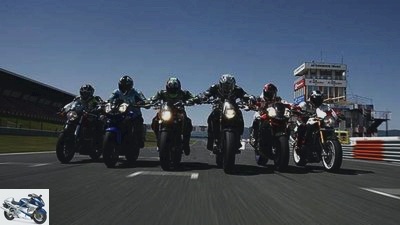
motorcycles
Two-cylinder special: base against noble
Two-cylinder special: base against noble
For a handful of dollars more
Content of
Sure, you can buy almost anything for money. If you believe the manufacturers, they even turn a naked bike into an uncompromising racing roll for a few extra notes. Indeed? Are the souped-up variants of the Monster, Super Duke, and Tuono that much better than the base? The racetrack gave answers.
Uwe Seitz
02/15/2008
A little after 9 o’clock. Kilo-Gixxer pop by, anyway, the whole liter fraction from the Far East is already on the route. Super athletes screech in the highest tones, it’s warm, sunny, dry. The smell of burnt gasoline and rubber already hangs in the air? There is a tingling sensation. But instead of joining these ranks, grabbing the motorcycle deep by the stub and chasing the competition and the ultimate lap time, there is a question in the room that simply needs to be clarified.
Especially the European two-cylinder manufacturers have no later than the appearance of the KTM 990 Super Duke R. a common product strategy. In addition to the basic model, the customer has a? Factory-tuned ?? Variants are available, which on the one hand promise a plus in performance and on the other hand cost a not inconsiderable amount of money more. In the case of our test field, it starts with 1200 euros at the KTM and goes up to 2835 euros for the Ducati Monster S4Rs. Engine tuning? Nothing. Both the basic and the noble versions are each fired by the same unit. The one more PS here and there is pure series production.
So let’s be honest: do you put so much money into your hand to go bunny-hunting with it in front of the cafe or just to pound it down the country road at the weekend? Okay, with the surcharge, specially coated forks shine in gold, glow special paintwork, cover carbon instead of disdainful plastic or dampen Ohlins instead of Sachs. That might make an impression. But people ?? all that matters is action. That literally calls for a test in pure PS style: Because there is only one test field for the tightened supplements? a fast, tricky and sometimes bumpy thoroughbred racetrack. With this in mind, we packed the six twins into the sprinters and are now standing at the pit exit in Most, Czech Republic.
The 1000 twin completes in both with sometimes wild twitching Aprilia Tuono the warm-up laps. If the Mille engine has to start working again and again, as it were, from idling, you can clearly see its roughness, and otherwise it doesn’t run smoothly mechanically either. That doesn’t settle in racing mode with warm tires either, namely when the tight right-hand bend is pending in Most after a tricky winding process. Due to the labyrinth of curves, the load changes tremendously in the 60-degree Rotax framework.
If the load is finally around the corner, the drop in performance is noticeable below 7000 rpm. That’s why it’s better to step down the Tuono a gear than the feeling suggests. Once the penny has dropped, the Tuono pounds over the asphalt with a lot of smoke and is long, but appropriately translated, especially for the fast sections of this route.
In terms of engine characteristics, the Testastretta of the two monsters is beyond any doubt. There’s a real racehorse in here, which after all comes from the 998. The Aprilia engine does produce a few more horsepower, but the V2 from Noale can only dream of the smoothness, ease of revving and, above all, the sparkling clean throttle response of the L-Twin? and measured 129 hp in a naked bike is a fat achievement. The little pauses that the engine takes between 6000 and 8000 rpm are to be tolerated, because just above it it burns brightly up to the locking speed.
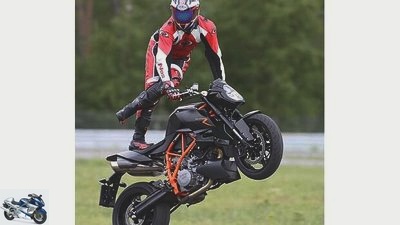
Relaxed gymnastics are always an effective means of combating tiring sitting.
The only downer in the Ducati’s drivetrain is the transmission. Both the author and the co-testers Tode and Jacob repeatedly jumped out of second gear when downshifting in front of the slow corners, once the gearbox even landed between 3rd and 4th gear when accelerating. The transmission demands precision and conscientiousness, and these two virtues compel the driver to move the ankle vigorously.
Not so with the Super Dukes. The corridors slide smoothly here. As soon as a signal flashes in the brain, the right gear is in place. The short translation conjures up a radiance under the helmet. With 120 hp, the Duke is the weakest on the chest, but you only believe that when you go down the long start / finish at the end of the lap. This 75-degree twin is certainly one of the best two-cylinders around. The LC8 delivers pure driving pleasure thanks to its smoothness and excellent throttle response. The test bench dispelled the initial suspicion that the black Duke with the orange R on the tank has a different mapping than its cheaper sister. All tester throttle hands attested that the R had an even more beautiful, because more harmonious, draft. There it is again, the famous series spread.
And that is the end of the pairwise similarities and gross brand differences. From now on, each of the six is on their own, and especially the high-priced ones are allowed to show whether they are worth their money. First and foremost, the souped-up bikes offer a more valuable chassis. Ohlins dampers work at the Tuono R Factory and the Monster S4Rs, while the noble Austrian builds on the now in-house White Power parts.
The monsters are allowed to be the first. She rocks her rider violently, forcing him to go the very wide line and, with the very soft setup on the fork combined with the ultra-toxic brake, provides some nasty surprises. This motorcycle is perfect for stoppies, but please don’t approach a slow corner! This applies to both variants, and in the standard setup the S4Rs equipped with Ohlins has only slight advantages. At the front the Duc is too fast on the block, at the back it pumps and wriggles tremendously. In addition, there is the problematic structure of the motorcycle, which stretches the driver far forward over the tank, creates an active driving experience for him and gives him little feeling for the front wheel. At the rear, the monster pulls in deeply when accelerating, and the low-hanging rear makes precise handling difficult. The Monster seems unstable in all situations and owes its only plus point in this category to the new first tires, the Michelin Pilot Power. That is not enough for us, which is why we are turning a lot of the set-up screws: With that, the S4R is already out of the running, because the Showa fork and Sachs shock absorber may still have some reserves ready for the country road, but they are overwhelmed in Most. With the S4Rs, we lift the rear end by a full 10 millimeters using the pushrod of the swing arm. The rebound stage is turned up 9 clicks, while the compression stage with one click clearly shows that the Monster is underdamped and that its spring is too soft. Then it’s the turn of the fork to adapt the chopper-like towering front to the terrain. After we had initially fully preloaded the fork, two revolutions back brought the best result. The rebound stage was 10 clicks on, while the compression stage was fully closed.
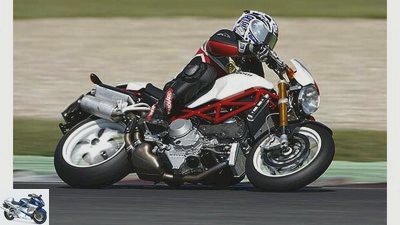
The Money Monster gains stability and agility compared to the base.
Lo and behold: all of a sudden, much tighter lines appear. Much tighter at the front, the Money Monster was much easier to give in because it gave more feeling. In general, the S4Rs gained in stability and maneuverability. However, the pretensioning of the fork springs does not hide the insufficient spring rate, which is why extreme caution is still advisable when using the front brake. As well as the measures on the chassis worked, the naked Ducati doesn’t get really sporty, and the fun factor on the track is limited.
This is always present on the KTM 990 Super Duke, as PS is always happy to certify the base model. But this time different rules apply, which is why the Super Duke R quickly pushes its sister into the pits. The higher rear with the ultra-hard seat, the steeper fork and the stiffer chassis quickly show that the R is making the brand-internal race. However, you have to get used to the seating position, because for a racetrack planer, the driver sits high on the hard mono rear end. That is probably the attraction of this motorcycle: It just feels different, and you have to focus on it. The black Duke sweeps across the slope with great stability on the brakes. Turning in and turning over are also playful on the R. No doubt about it, the Super Duke R is the most agile of the bunch. The relatively narrow handlebars support this feeling. With the Dunlop D 208 RR, the bike has matching soles.
However, the setup is a headache. The response behavior of the titanium nitride coated fork is somewhat insensitive, the breakaway torque is noticeable. The adjustment range of the WP fork, on the other hand, is completely okay, there is nothing to complain about. On the other hand, the rear of the strut snaps out so quickly in the undulating uphill section before the start / finish that it begins to fidget at the back. This suggests that the rebound stage is too wide open. However, several adjustment attempts revealed that the WP shock absorber of the R-Duke does not really meet the demands of the KTM strategists. The R is clearly underdamped at the rear in the rebound stage, while the compression stage is as hard as a board. And while a real racing strut still offers reserves in the optimal setting, the strut of the R always hit through and pressed our cable tie into the rubber damper. The best possible setup looked like this: On the fork, the compression stage opened 7 clicks, the rebound stage 17 clicks. The compression stage on the shock absorber 15 clicks at low speed and 2.5 turns at high speed. Open the rebound stage with a maximum of 1 click. A harder spring with less preload could help here. In any case, the result is disappointing for a top-end variant. On the country road, this chassis would certainly be way ahead, but on the racetrack it reaches its limits far too quickly. Perhaps one or the other black painted part of the R would have preferred to stay orange, and instead they would have made more effort with the shock absorber for the 1200 euros extra charge. The Super Duke R would not only have the potential to be a real piste horror because of the bold, angular styling in matt black, the fade-free, gripping brakes, the great motor and the silky transmission.
But if you have to go naked on the racetrack, there is hardly a way past the Tuono R Factory. No wonder: the motorcycle stands on exactly the same heels as the flawless racing version, the RSV 1000 R Factory. And that’s exactly why the Tuono drives the bends best by far, lies absolutely neatly in long arcs along the desired line and gives the driver absolute confidence in the load. Driving into the curve is especially fun. This feeling for the front wheel is simply super athlete level. Even the wide and towering handlebars cannot prevent that. What the Tuono also favors is its seating position. With her you actually have the feeling of sitting in the motorcycle in a really sporty way. Only the brutal knee angle may be criticized, which is especially true for country road use. For whom, however, the factory would be totally overdressed: The basic Tuono does just as well here. On the racetrack it has to be attached quickly due to the lack of adjustment options on the shock absorber and the small reserves on the chassis. For the 1900 Euro surcharge of the factory, the noble Tuono also offers forged wheels, which also accommodate the handling. The Tuono looks huge compared to the Monster and Super Duke, but once in motion, nothing indicates that it is 4 or 2 kilograms heavier. Well, it demands a little more effort than the KTM from its rider, but it offers a chassis that is beyond reproach and whose set-up succeeds without excitement. Fork: compression 3 clicks on, rebound 14 clicks on. Shock absorber: compression 1 click on, rebound 19 clicks.
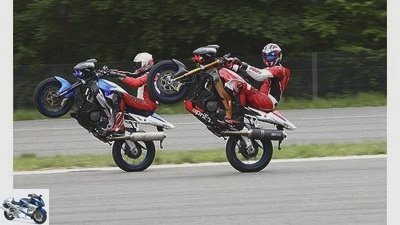
A low-wear use of front tires is a matter of the heart for every horsepower driver.
Fortunately for Tuono, which would make the factory a god of thunder, it lacks an engine like the Testastretta or the LC8. No matter how dreamily the chassis may take on hairpin bends and narrow terrain, the characteristics of the Rotax are always the fly in the ointment. However, this is considerably more disadvantageous on the country road than in Most.
Conclusion: For the extra money, the inclined customer gets a vehicle that is superior to the basis. However, the plus in performance is not always what you might expect. The S4Rs calls for a whopping 2835 euros more to actually just be the better country road motorcycle. The R version of the KTM already has more to offer: great engine, nasty styling, mono tail, modified geometry and pimped up chassis. The shock absorber is anything but “Ready to Race”. Of all things, the cheapest bike among the luxury variants wins the race: The Tuono 1000 R Factory shines with a top chassis, it couldn’t be better. We’re just waiting for the new Aprilia engine.
DATA
Aprilia Tuono 1000 R Factory
Drive: two-cylinder 60-degree V-engine, 4 valves / cylinder, 102 kW (139 PS) at 9500 / min *, 107 Nm at 8500 / min *, 998 cm3, bore / stroke 97.0 / 67.5 mm, compression ratio 11.8: 1, 57 mm throttle valves, hydraulically operated multi-disc oil bath clutch, six-speed gearbox, G-Kat
Chassis: light alloy bridge frame, steering head angle: 65.0 degrees, caster: 104 mm, wheelbase: 1410 mm, Ohlins USD fork, Ø fork inner tube: 43 mm, adjustable in spring base, compression and rebound, Ohlins shock absorber with deflection, adjustable in spring base, compression and rebound stage (spring suspension and rebound stage) **, spring travel v./h .: 127 (120) ** / 133 mm
Wheels and brakes: light alloy forged wheels (cast iron) **, 3.50 x 17 ?? / 5.50 x 17 ??, tires from: 120/70 ZR 17, h .: 180/55 (190/50) ** ZR 17, first year: Pirelli Superc. Pro, 320 mm diameter disc with four-piston fixed calipers at the front, 220 mm disc with two-piston fixed calipers at the rear
Dimensions and weights: L / W / H: 2027 /
830/1100 mm, seat / handlebar height: 840/1030 mm, length width: 760 mm, 206 (213) ** kg fully fueled, v./h .: 48.8 / 51.2% (48.6 / 51.4%) **
Rear wheel power in last gear: 88 kW (120 PS) at 265 km / h (86 kW (117 PS) at 259 km / h) **
Performance: Acceleration 0 100/150/200 km / h: 3.5 / 6.0 / 10.2 (3.3 / 5.9 / 10.5) ** s, pulling speed 0 100/100 150 km / h: 6.2 / 6.3 (6.5 / 6.5) ** s
Top speed: 255 km / h *
Consumption: Fuel type: Super,
Average test consumption: 8.2 (8.0) ** liters /
100 km, tank capacity: 19 liters, range: 232 (238) ** km
Price: 13399 (11499) ** Euro plus additional costs

The trend color white has adorned the S4Rs for a long time.
Ducati Monster S4Rs
Drive: two-cylinder 90-degree V-engine, 4 valves / cylinder, 89 kW (120 PS) at 9000 / min *, 100 Nm at 7000 / min *, 997 cm3, bore / stroke 101.0 / 62.4 mm, compression ratio 11.5: 1, 50 mm throttle valves, hydraulically operated multi-plate dry clutch, six-speed gearbox, G-Kat
Chassis: Steel space frame, steering head angle: 66.0 degrees, caster: 94 mm, wheelbase: 1440 mm, Ohlins USD fork, TiN-coated sliding tubes (Showa fork) **, Ø fork inner tube: 43 mm, adjustable in spring base , Compression and rebound stage, Ohlins (Sachs -) **, spring strut with deflection, adjustable in spring base, compression and rebound stage, spring travel from / h .: 130/148 mm.
Wheels and brakes: cast light alloy wheels, 3.50 x 17 ?? / 5.50 x 17 ??, front tires: 120/70 ZR 17, rear: 180/55 ZR 17, first tires: Michelin Pilot Power, 320 mm double disc with four pistons -Fixed calipers at the front, 245 mm disc with two-piston fixed calipers at the rear
Dimensions and weights: L / W / H: 2120 /
880/1240 mm, seat / handlebar height: 810/980 mm, length width: 750 mm, 203 (204.5) ** kg fully fueled, v./h .: 48.3 / 51.7 (48, 7 / 51.3) **%
Rear wheel power in last gear: 86 kW (117 PS) at 232 km / h (88.0 kW (120 PS) at 230 km / h) **
Performance: Acceleration 0 100/150/200 km / h: 3.4 / 5.8 / 10.2 s, pulling 50 100/100 150 km / h: 5.2 / 5.5 s , Top speed: 245 km / h *
Consumption: Fuel type: Super,
Average test consumption: 7.3 (7.1) ** liters /
100 km, tank capacity: 14 liters, range: 192 (197) ** km
Price: 15130 (12295) ** Euro plus additional costs
KTM 990 Super Duke R.
Drive: two-cylinder 75-degree V-engine, 4 valves / cylinder, 88 kW (120 PS) at 9000 / min *, 100 Nm at 7000 / min *, 999 cm3, bore / stroke: 101.0 / 62, 4 mm, compression ratio: 11.5: 1, 48 mm throttle valves, hydraulically operated multi-disc oil bath clutch, six-speed gearbox, G-Kat
Chassis: Steel space frame, steering head angle: 67.3 degrees (66.1 degrees) **, caster: 94 mm (100.7 mm) **, wheel base: 1450 mm, Ø USD fork, TiN-coated sliding tubes ( chrome-plated sliding tubes) **, Ø fork inner tube: 48 mm, adjustable in spring base, compression and rebound stage, suspension strut, adjustable in spring base, compression and rebound stage, spring travel v./h .: 135/150 (160) ** mm
Wheels and brakes: light alloy cast wheels, 3.50 x 17 ?? / 5.50 x 17 ??, front tires: 120/70 ZR 17, rear: 180/55 ZR 17, first tires: Dunlop Sportmax D 208 RR 320 mm double disc with Four-piston fixed calipers at the front, 240 mm disc with single-piston floating caliper at the rear
Dimensions and weights: L / W / H: 2080/910 /
1235 mm, seat / length height: 865/1040 (845/1030) ** mm, length width: 750 mm, 202 (220.5) ** kg fully assembled, v./h .: 51 , 7 / 48.3% (48.3 / 51.7%) **
Rear wheel power in last gear: 82 kW (111 PS) at 229 km / h
Performance: Acceleration 0 100/150/200 km / h: 3.1 / 5.7 / 10.7 (3.4 / 6.0 / 11.0) ** s, pulling 50 100/100 150 km / h: 4.7 / 4.6 (4.9 / 4.6) ** s,
Top speed: 220 km / h *
Consumption: Fuel type: Super,
Average test consumption: 9.2 (8.5) ** liters /
100 km, tank capacity: 18.5 liters, range: 201 (218) ** km
Price: 13698 (12498) ** Euro plus additional costs
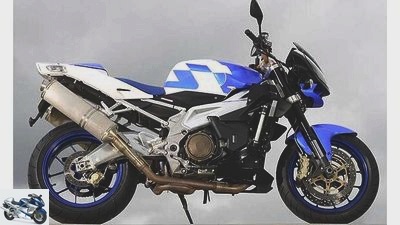
The Tuono engines must be clearly springy on the test bench.
MEASUREMENTS
Of the nominal 139 HP on the crankshaft, the Tuono R only has 127 HP left on the test bench. That is really bad. The factory with 131 measured horsepower also loses too much. In addition, there is the slump at 6000 rpm in the case of the Factory. The Testastretta does it the other way around ?? what we much prefer to see: Instead of the promised 120 hp, it serves decent surcharges on the test bench, namely 128 or 129 hp, but also takes a break after 6000 rpm. In contrast, the performance range of the two KTM twins is very harmonious. Pressure away from idle, they outperform their competition at medium speeds. But with just over 120 hp, the two of them call it a day, but as expected they are the torque kings.
REVIEWS
Aprilia Tuono 1000 R
drive
It’s fun at over 7000 rpm, but then really. The smoke is okay, but load changes and hard throttle response spoil the fun? even on the slopes.
landing gear
It would be enough for the highway. The response behavior is okay, the missing pressure level is particularly missed on a hard track pace.
ergonomics
The wide handlebars, the tidy seat, the feeling for the bike ?? that fits. However, the knee angle is pretty sharp for normal use.
Driving fun
The Tuono is a fun event on fast roads and with committed speed. Narrow forest roads and through-roads should be avoided.
verdict
The cheapest, but not the worst motorcycle. Attractive chassis, good brakes and an exciting exterior almost make up for the rumbling Rotax.
4th place, 14 points

The Tuono R Factory is a real burner and also cheaper than the competition.
Aprilia Tuono 1000 R Factory
drive
The rough engine of the Tuono almost brought it about the victory, but its deficits are not that serious on the racetrack.
landing gear
Ironing the racetrack with this nude is fun. The Factory can be driven flawlessly over the front wheel, its chassis is ?? Racing ??.
ergonomics
The knee angle may be sharp, but that’s okay in speed mode. In the factory you sit right in and have a good feeling for the attack.
Driving fun
On the wide handlebars, aggressively in the Tuono around the long arches of Most and then ducking deep down the long start / finish? Fun? Oh yeah!
verdict
For a surcharge of 1900 euros you get a real naked burner, which is also cheaper than the noble competition. Congratulations, Factory!
1st place, 17 points
Ducati Monster S4R
drive
The Testastretta is mature: lively, smooth-running, great response. The low between 6000 / min and 8000 / min fortunately eliminates the last point.
landing gear
The soft fork with the brutal brake is a bad combination. The shock absorber also avoids the sport. Thanks for the Michelin Pilot Power.
ergonomics
Do you still have to say it? The driver sits stretched out inactive and uncomfortable. Monster driving is old school, HP demands progress!
Driving fun
Only the engine is really fun. The chassis does not fit, the brakes are dangerous, and a rack may even be more convenient.
verdict
It has sold well over the years, but the Monster needs to be re-engineered. Please do not hang the great 1098 in the thing as well!
6th place, 11 points
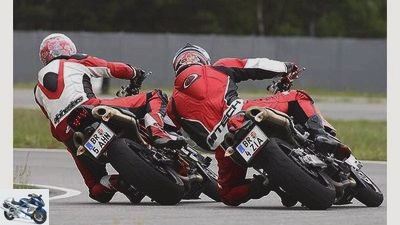
Among the basic models, the Super Duke does not hold up to any of the other models.
Ducati Monster S4Rs
drive
A real racehorse, this Testastretta. In politics, however, one would say when looking at the whole: the right man in the wrong place.
landing gear
For the hefty surcharge, the Ohlins components are unfortunately only mass-produced goods. Even the standard Tuono’s fork works better.
ergonomics
The handlebars are strangely cranked and very far forward, the tank bulging and long: Active sitting works a lot differently.
Driving fun
At Ducati, hobby and cult play a more important role than performance. It’s only really fun on the joyride to the ice cream parlor.
verdict
The S4Rs dresses in a racer garb, but is just the better country road monster. There is fun between two ice cream parlors ?? for over 15,000 euros.
5th place, 13 points
KTM 990 Super Duke
drive
A great engine ?? no doubt: cultivated, spontaneous throttle response, harmonious performance. Now a little more top power and 5 stars shine.
landing gear
The softer chassis of the base allows for more movement, but the R is hardly faster. On the country road, the base has a clear advantage.
ergonomics
For the attack on the racetrack you sit quite high. Nevertheless, everything finds its place and the driver participates in the action with all of his senses.
Driving fun
When it comes to driving fun, the standard Super Duke is a favorite with horsepower. Boom, boom, bang ?? pretty much everything is easy, the KTM just lacks a little pressure.
verdict
Among the basic models, which should rather show their strengths in everyday life, the Super Duke does not hold up to any of the other standard versions.
2nd place, 16 points
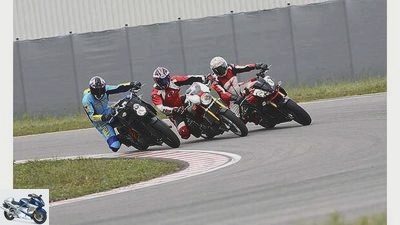
For a surcharge of 1200 euros, you can expect more racing from the Super Duke R..
KTM 990 Super Duke R.
drive
Impeccable character. However, it becomes clear on the racetrack that there are only 120 horses waiting. But it is still enough to four stars.
landing gear
Only on the racetrack does the R brave. The shock absorber lacks reserves, the rebound stage is slack. The adjustment range of the fork, on the other hand, is okay.
ergonomics
On the racetrack, the steeper rear end and the hard mono seat make more sense than the standard bench ?? but really only here. You just have to like it.
Driving fun
Agile, manoeuvrable, with good brakes and an independent feeling. That is fun. However, the one with a different strut should be larger.
verdict
After the base duke, the anticipation was great. Even if 1200 euros is the lowest surcharge among the noble ones, you can expect more racing.
2nd place, 16 points
Related articles
-
This is how it works: Adjust the spring base yourself
accesories landing gear & Spring elements This is how it works: Adjust the spring base yourself This is how it works: Adjust the spring base Adjust the…
-
Chassis special: Part 6 – Troubleshooting the front of the vehicle
archive accesories landing gear & Spring elements Chassis special: Part 6 – Troubleshooting the front of the vehicle Suspension special: troubleshooting…
-
Suspension special: Part 7 – rear
archive accesories landing gear & Spring elements Suspension special: Part 7 – rear Suspension special: rear Does the motorcycle drive strange lines?…
-
Suspension special: Part 3 – Strut damping
triumph accesories landing gear & Spring elements Suspension special: Part 3 – Strut damping Suspension special: shock absorber The right set-up for the…
-
Chassis special: Part 2 – fork damping
fact accesories landing gear & Spring elements Chassis special: Part 2 – fork damping Chassis special: fork damping Front wheel damping – the dream setup…
-
Chassis special part 1: motorcycle suspension
fact accesories landing gear & Spring elements Chassis special part 1: motorcycle suspension Chassis special: suspension Everything about motorcycle…
-
Chassis Special: Part 5 – Troubleshooting and Basics
Jahn accesories landing gear & Spring elements Suspension special: Part 5 – Troubleshooting and basics Suspension special: troubleshooting and basics…
-
K motorcycles All-rounder on the racetrack All-rounder on the racetrack Wrong world Content of Motorcycles have a purpose: they are light, disguised and…
-
Comparison test: large naked bikes
K motorcycles Comparison test: large naked bikes Comparison test: Large naked bikes, Ducati Monster S4, Kawasaki Z 1000, KTM 990 Super Duke R, Triumph…
-
Comparison test: BMW R 1200 GS, Ducati Hypermotard 1100 S, KTM 990 Supermoto
Jahn motorcycles Comparison test: BMW R 1200 GS, Ducati Hypermotard 1100 S, KTM 990 Supermoto Comparison test: BMW R 1200 GS, Ducati Hypermotard 1100 S,…